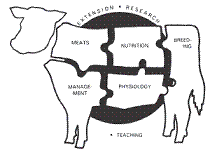Animal Science, Department of

Nebraska Beef Cattle Reports
Date of this Version
2021
Citation
Published in 2021 Nebraska Beef Cattle Report, University of Nebraska Extension Publication MP110
Abstract
This study was conducted to evaluate the relationship between animal oxidative status, using lipopolysaccharide (LPS) as a promoter for oxidation. This was used as a model to evaluate tenderization and meat quality factors early postmortem. Lambs were administered an intravenous injection of either saline, 50 ng/kg bodyweight (LPS50), or 100 ng/kg bodyweight (LPS100) every 72 hours for a 9- day period to stimulate physiological oxidative stress. After a day of rest, lambs were harvested, and pre- rigor Longissimus dorsi-muscles were obtained for transcriptomic analysis. Loins, aged for 1 and 14 days, were analyzed for attributes relating to oxidative potential, meat tenderness, color, and lipid stability. Results show lambs administered lipopolysaccharide treatments exhibited greater oxidative potential, as indicated by increased rectal temperatures, and upregulated expression of mRNA protein pathways essential for cellular differentiation, proliferation, and apoptotic events. Lambs administered LPS50 tended to be more tender early postmortem, with significantly increased proteolysis (Troponin T). Interestingly, LPS treatment was not detrimental to meat quality, as indicated by more ideal color values and no significant changes in lipid oxidation. These data indicate that oxidative potential via oxidative stress can potentially increase tenderization early postmortem, which may provide more tender meat with no detriment to other meat quality factors.
Included in
Large or Food Animal and Equine Medicine Commons, Meat Science Commons, Veterinary Preventive Medicine, Epidemiology, and Public Health Commons


Comments
Copyright © 2020 The Board of Regents of the University of Nebraska.